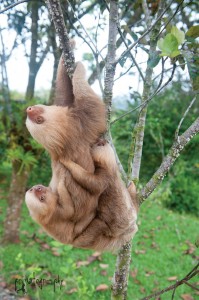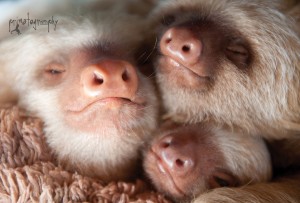Sloth Re-Entry Project
By Seda Taysi Sejud, Owner of Villa Perezoso and KSTR Volunteer
 Pelota. Ellen. Kermie. Three of the cutest, sweetest, and most special two-toed sloths you will ever meet. Their story is one that we hope will make scientific history and provide vast amounts of knowledge about sloth behavior that hasn’t existed until now. What makes these three so incredibly special and unique is that they were brought to KSTR as orphans and have been successfully hand raised by an amazing group of volunteers led by “sloth mama” Sam Trull who serves as the organization’s Wildlife Manager and “mom” to the orphans.
Pelota. Ellen. Kermie. Three of the cutest, sweetest, and most special two-toed sloths you will ever meet. Their story is one that we hope will make scientific history and provide vast amounts of knowledge about sloth behavior that hasn’t existed until now. What makes these three so incredibly special and unique is that they were brought to KSTR as orphans and have been successfully hand raised by an amazing group of volunteers led by “sloth mama” Sam Trull who serves as the organization’s Wildlife Manager and “mom” to the orphans.

While there are instances of adult sloths being released back into their original habitat, this will be one of the first times in Costa Rica that hand-raised orphaned sloths will be released back to the wild. And, from the information that is known the first in the world where hand raised orphans will be released with GPS tracking collars. This is where we need your assistance, as this feat cannot be achieved without your help.
Raising the orphans
All three of these orphans found their way to KSTR having been orphaned and abandoned by each of their mothers in Manuel Antonio, Costa Rica, home to many sloths. It is unclear why this may have happened, oftentimes mothers are attacked by a predator or have been electrocuted and the babies are left to die (baby sloths, much like human babies, are totally dependent on their mothers for their survival).
Two toed sloths typically spend up to two years with their mothers learning how to be wild. Three- toed sloths spend between 6 months and 1 year with their mothers learning to be wild. This time allows for the young to gain weight to stay warm, to learn how to find good shelter, what to eat, how to climb and to learn about predator avoidance. Pelota, the oldest of the three, was brought in at around 3 months as was Ellen. Each weighed approximately 600 grams or 21 ounces, a little over a pound! Little Kermie, was brought in as a newborn barely weighing ½ pound. Through great care, Sam simulated a safe and healthy environment, one that included plenty of climbing structures, yummy sloth food and lots of comfort for the orphans; the three not only flourished but became inseparable. Eventually, Sam’s apartment, turned baby sloth residence, was no longer a viable residence option for the growing threesome. And with hopeful plans in play for their eventual release, the day came when the three needed to “spread their wings”. They were placed outdoors, starting with a few supervised hours at a time, in a rehab cage, outfitted with branches and sloth hammocks to begin their transition, until eventually they were able to spend all of the day and night alone but together.
The Boot Camp Enclosure
The current rehab cages are not sufficiently large or natural enough to provide a learning environment that allows a weaned orphaned sloth a chance to grow into a wild sloth before facing the dangers of the wild on their own. The small rehab cages were designed for short-term residents (those brought in as a result of electrocutions, dog attacks, etc.) not for long-term residents like orphaned sloths. However, baby and young sloths are one of the most frequent of animal species brought in to the wildlife clinic.
KSTR, with the help of volunteers and donors are planning on building this critical enclosure during the month of June 2014. Not only will the sloths benefit from this pre-release, but other animals could also practice here like orphaned anteaters and adult sloths that need some climbing practice before their return to their habitat. Taking them for walks in the jungle is not enough practice at this stage in their life and it’s not practical with nocturnal animals that are already learning to be independent (two toed sloths are nocturnal!). KSTR is very excited to have such an enclosure to add to their facilities. (In addition to the threesome, we have two other sloths that could benefit from this enclosure and that number is only going to grow. They deserve the best chance at a successful release and this is their next step).
The Release!
GPS tracking backpacks/collars, specially designed for sloths are an essential part of this release program. Information provided by these collars will not only help KSTR keep track of the sloths to gauge their health, happiness and safety but will lend valuable information for publications and studies on setting standards for how to raise and release orphaned sloths. GPS technology is constantly developing and this is only the beginning of the kinds of studies we could do to learn more about sloth conservation.
 Virtually nothing is known about sloth behavior and ecology. We need to learn more about the sloths in the Manual Antonio region. Please play a part in helping us maintain and keep this species alive. For Pelota, Ellen and Kermie. For all baby sloths.
Virtually nothing is known about sloth behavior and ecology. We need to learn more about the sloths in the Manual Antonio region. Please play a part in helping us maintain and keep this species alive. For Pelota, Ellen and Kermie. For all baby sloths.
KSTR is actively pursuing fundraising and volunteer assistance with the Sloth Project. We are aiming to raise $50,000 total; a $100 per person donation would help towards this attainable goal. Smaller or larger donations are always welcome. If you are aware of any corporations that might also be interested in a sponsorship, please let us know.
To learn more about how you can help, please contact [email protected].
